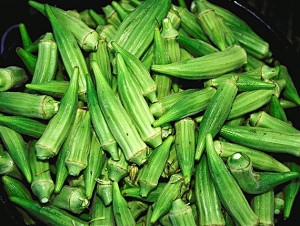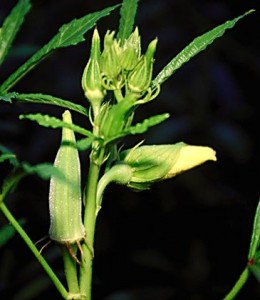 Okra or Lady’s Finger (Abelmoschus esculentus; it is occasionally referred to as Hibiscus esculentus L.), a flowering plant in the mallow family, making it a relative of cotton, cocoa, and hibiscus. Okra is a plant native to Ethiopia, where it has been cultivated and used for centuries. Valued for its edible green fruits, Okra is an annual or perennial, growing to 2 m tall, and sometimes even higher, in the right conditions. The leaves are 10–20 cm long and broad, palmately lobed with 5–7 lobes. The flowers are 4–8 cm diameter, with five white to yellow petals, often with a red or purple spot at the base of each petal. The fruit is a capsule up to 18 cm long, containing numerous seeds. It is rich in vitamin C, magnesium, and folate, making it a useful addition to the human diet.
Okra or Lady’s Finger (Abelmoschus esculentus; it is occasionally referred to as Hibiscus esculentus L.), a flowering plant in the mallow family, making it a relative of cotton, cocoa, and hibiscus. Okra is a plant native to Ethiopia, where it has been cultivated and used for centuries. Valued for its edible green fruits, Okra is an annual or perennial, growing to 2 m tall, and sometimes even higher, in the right conditions. The leaves are 10–20 cm long and broad, palmately lobed with 5–7 lobes. The flowers are 4–8 cm diameter, with five white to yellow petals, often with a red or purple spot at the base of each petal. The fruit is a capsule up to 18 cm long, containing numerous seeds. It is rich in vitamin C, magnesium, and folate, making it a useful addition to the human diet.
Okra is notorious for the mucilaginous substance found inside the pods. Depending on how it is cooked, okra can be extremely slimy, and some people find this texture repellent. The thick goo can also be advantageous, however, as when okra is used in soups and stews as a thickener. To reduce the slimy texture of okra, many cooks like to cook it with acidic ingredients which will cut through the slime, and some believe that okra benefits from being cut, lightly sprinkled in salt to draw out the slime, and allowed to rest for 15-20 minutes before cooking.
Okra plants are extremely drought and heat resistant and okra is a popular vegetable in many countries with difficult growing conditions.
Okra can be grown on a wide range of soils, provided the internal soil drainage is good. Soils high in organic matter are preferred. It does best in rich, well-draining soil. It’s not particular about soil pH (6.5 – 7.5), but it won’t thrive in heavy, soggy soils.The plant is widely cultivated throughout the year in the tropics.
How to grow Okra
Recommended Varieties of Okra
The two recommended varieties of okra include Smooth Green, which is preferred by the consumers because of the deep green appearance and Native variety with yellowish white fruits preferred by retailers because it doesn’t appear wilted if kept for several days. Other desirable characteristics of these varieties:
- Smooth green variety have deep green color. It is harvested after 45 days and yields 25 tons per hectare. It’s fruiting behavior is prolific.
- Native white variety have yellow green color. It is harvested after 45 days and yields 20 tons per hectare. It’s fruiting behavior is moderately prolific.
Site Selection/Soil Type
Choose an elevated area with adequate source of water during dry season. Okra thrives well in sandy loam, loam or clay soil with pH of 5.8-8.0.
Planting Season
Okra grows anytime of the year. If grown in lowland areas from October to December, high yield and more profit can be attained. Growing okra on hilly areas from May to July is also profitable.

Land Preparation
Broadcast organic fertilizer or compost (please refer to Table 2) before plowing the area. For sandy loam soil, plow and harrow once. For clay loam soil, plow and harrow once if the soil is moist. However if the soil is cloddy, harrow 2-3 times to attain good soil tilth. Set furrows at 75 cm apart for wet season and 100 cm for dry season planting.
System of Planting
If the furrowed soil is moist, take advantage of the moisture content of the soil. Drill 2-3 seeds per hill in the furrows at a distance of 30 cm and cover the seeds with 3.0 cm depth of soil, then press lightly to prevent excessive loss of moisture. This system of planting, which is usually practiced by farmers favors deeper root penetration of seedlings and avoids the early emergence of weeds.
The common practice in seeding is planting the seeds before irrigating the field, causing weed seeds to germinate faster than the okra seeds, resulting in more labor input in weeding. A 1000 m2 area requires 1 kg of seeds.
During rainy season, plant the seeds on raised beds or at the ridge of furrows to prevent the plants from water logging in case of flush floods.
Fertilizer Application
For vigorous growth of okra and to prolong the productive period, apply foliar fertilizer late in the afternoon or early in the morning after the dew on the plants have evaporated to avoid burning effect on the leaves and stems.
Weeding and Cultivation
Cultivate and hill-up by hand-hoeing in between furrows at 14 DAE to suppress the emerging weeds. Finally hill-up at 42 DAE or one month after. At such stage, the profuse foliage cover of the crop is enough to suppress the growing weeds. Uproot the remaining weeds (spot weed) that were missed during the previous cultivation.
Irrigation
If the crop is planted in moist soil and was not irrigated after planting, irrigate the area at 14-21 DAE just after hilling-up. At such stage, the water will easily subside in the soil and the roots will be forced to pursue the water, favoring longer and deeper root penetration.
In light textured soils, irrigate or water at weekly interval. During dry season, irrigate 10-5 times for the entire period of production.
Pest Management
Okra is tolerant to most insect pests specifically during wet season because of the profuse growth of foliage, but diseases are common because of the wet–warm condition of the environment. However, during summer or second crop, leafhopper is the most damaging pest with occasional diseases. These can be managed using the suggested biological and remedial control measures presented (see below). If there are pest and disease outbreaks, refer to the suggested chemical control below.
Insect Pests of Okra
- Cotton stainer – A sucking insect pest of okra (Fig 2a) common throughout the year and attacks all parts of the plant. It does not significantly reduce the yield, but it lowers the quality of the fruits produced by inflicting a rusty appearance on the surface.
- Leaf folder (Lamprosema sp.) is a polyphagous insect pest that infests leafy vegetables. The larva (Fig. 2b) encloses itself in a leaf by forming into a fold using a web generated from within its body then feed in the inner surface of the leaf until it develops into a pupa. It affects the photosynthesis on the leaves.
- Leaf hopper (Impoasca sp.) – This is an insect pest (Fig. 2c) that feeds on okra by sucking the sap of the leaves. The effect of its feeding results in yellowing, cupping, and browning of the leaves, which is often called hopper burn. Under water stress condition, the plants cease to grow but bear small deformed fruits and shoots.
- Cecospora leaf spot or blight – Cercospora abelmoschi (Fig.3). The disease is common during wet season. The spread of the disease is favored by the wet-warm condition of the environment during wet season. High doses of nitrogen fertilizers applied produce succulent leaves that are susceptible to the attack of the fungus
Biological and remedial control of insect pests and diseases of Okra.
a. Leaf hopper
- Irrigate the area planted with okra twice a week to prevent or minimize drying of the leaves sucked by the pests. Enough water that is absorbed by the plant will compensate the sap sucked by the pest. Practice organic farming because organic nutrients will boost the immune system of the plant against pests.
b. Cotton Stainer
- Collect the insects and eggs and burn or bury these into the soil. Use overhead irrigation to reduce insect population.
c. Leaf Folder
- Crush folded leaves with thumb and forefinger to kill the larva inside the fold. Do not open the fold because the worm inside will quickly slide, fall, and hide inthe soil. Use light trap to kill adults
- Collect infected leaves, place these in a plastic bag and then seal. Expose the plastic bag under the sun to kill the worms.
- Spray with Thuricide HP or Dipel (Bacillus thuringiensis) following manufacturers’ recommended dosage. These are bacterial pesticides.
d. Cercospora and Leaf spot
- Gather all infected leaves as soon as the symptoms start to appear. To avoid transferring the disease to healthy leaves, burn infected leaves or bury these outside the area. Spray unaffected leaves with decoction of guava, avocado and Acapulco leaves (1 L decoction to 16 L of water)
- Remove some leaves (leaf thinning) so that the ultra violet rays of the sun can penetrate in between the leaves and kill the pathogens.
- Preparation of decoction: boil 1 kg leaves of each of guava, avocado, and Acapulco in 3 gallons of water for five minutes, start counting 5 minutes when the water is already boiling. Strain after cooking then store the decoction in plastics containers.
Harvesting
Okra has trichomes on the leaves and fruits. To avoid getting rashes when harvesting, wear long sleeved clothes and hand gloves.
Harvest immature fruits 5-10 days after flowering and every other day thereafter to obtain higher yield. Harvest in the morning when the dew have disappeared on the leaves. Pack the fruits in 10 kg polyethylene bags for convenience in hauling and to maintain freshness. Too much moisture favors the development of molds on the packed fruits so puncture 4-5 small holes on each plastic bag.
Source: www.openacademy.ph; Photos: wikimedia